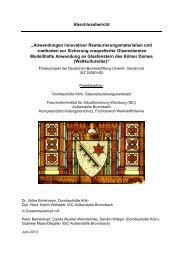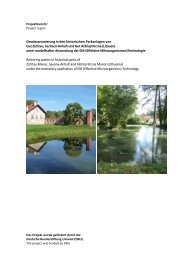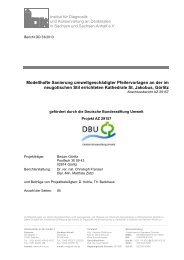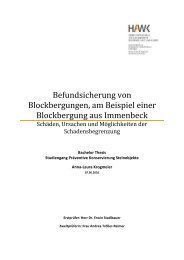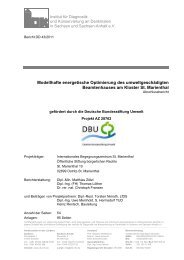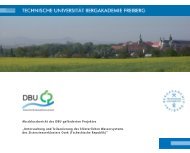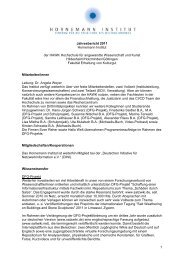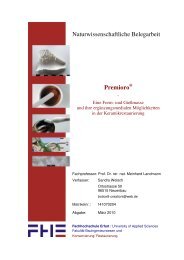Download PDF
Download PDF
Download PDF
Sie wollen auch ein ePaper? Erhöhen Sie die Reichweite Ihrer Titel.
YUMPU macht aus Druck-PDFs automatisch weboptimierte ePaper, die Google liebt.
Weichmacherverlust bei PVC-Objekten von Joseph Beuys – Versuche zu kurativen und konservatorischen Massnahmen<br />
ANHANG III: ZUSAMMENSTELLUNG VON ABSTRACTS<br />
UV-Bestrahlung<br />
Duvis, T.; Karles, G.; Papaspyrides C. D. (1991): Plasticized PVC films/petroleum oils: The effect of<br />
ultraviolet irradiation on plasticizer migration. In: Journal of Applied Polymer Science, Volume 42, Issue 1,<br />
Date: 5 January 1991, S. 191-198<br />
Abstract<br />
Plasticizer migration from flexible poly(vinyl chloride) comprises an important aspect, especially when packaging<br />
foodstuffs and pharmaceuticals. Much of the published work has been intended either to correlate migration into<br />
simulants with that into foods or to study migration into simpler extractants, enabling the various parameters involved<br />
in migration to be studied in isolation. According to the latter approach, the migration of dioctyl phthalate into<br />
petroleum oils has been studied already in our laboratory and in this paper results are presented in an attempt to<br />
reduce or prevent migration by u.v. irradiation. The effect of irradiation time on short and long-term migration<br />
behavior was examined together with the influence of the immersion temperature. The nature of the liquid<br />
environment seemed to be a predominant aspect: high viscosity oils presented a satisfactory behavior in contrast<br />
with those of lower viscosity in which the prevention effect was rather negligible. On the other hand, primary kinetics<br />
studies yielded similar results with those already established for untreated material (i.e., good conformity to the short<br />
time Fickian approximation).<br />
Wolfgang Schneider (1982):<br />
Vernetzung von Polymeren durch energiereiche Strahlung in Gegenwart von polymerisierbaren<br />
Monomeren. Darmstadt, Eggenstein-Leopoldshafen: Forschungsgesellschaft Kunststoffe e.V., Deutsches<br />
Kunststoff-Institut<br />
Plasmabehandlung<br />
Jierong C.; Jing-Lian Y.; Yun-Ze Z. (2004): Surface modification of medical PVC by remote oxygen<br />
plasma. In: Composite Interfaces, 1 April 2004, vol. 11, no. 2, pp. 123-130(8)<br />
Surface modification of medical PVC by remote oxygen plasma has been studied: surface structure and performance<br />
of treated material are analyzed by weight loss rate, contact angle measurement and XPS. With the increase of<br />
sample distance from the plasma source, weight loss rate drops, electrons and ions and etching action are<br />
restrained; and C=O groups are found in the treated PVC surface. The surface wettability of PVC film can be<br />
improved by remote low-temperature plasma and the radical reaction is intensified.<br />
Loeschcke, I;. Friedrich, J.; Lutgen, P. (2003): XPS-Untersuchungen von im H2-Plasma erzeugten<br />
Polyenen in PVC. In: Acta Polymerica, 2003, Volume 41, Issue 10 , S. 553 – 554. Akademie der Wissenschaften<br />
der DDR, Zentralinstitut für Organische Chemie, Berlin, DDR-1199<br />
Bento, Wanderson C. A.; Honda, Roberto Y.; Kayama, Milton E.; Schreiner, Wido H.; Cruz, Nilson C.; Rangel,<br />
Elidiane C. (2003): Hydrophilization of PVC Surfaces by Argon Plasma Immersion Ion Implantation. In:<br />
Plasmas and Polymers, March 2003, Volume 8, Issue 1, pp. 1-11<br />
Commercial polyvinylchloride (PVC) sheets were treated by plasma immersion ion implantation, PIII. Samples were<br />
immersed in argon glow discharges and biased with 25 kV negative pulses. Exposure time to the bombardment




